
Booze, Broads, & Bullets: Man Without Fear
April 13th, 2010 by david brothers | Tags: bbbw, daredevil, frank miller, man without fearBooze, Broads, and Bullets continues! Tim O’Neil takes on the Tao of Miller! Tim Callahan posts a scan of Tales of the New Gods: Nativity by Frank Miller and then analyzes it in When Words Collide: Frank Miller’s New Gods! Chad Nevett looks at A Dame to Kill For! Check the index for the full slate of posts!
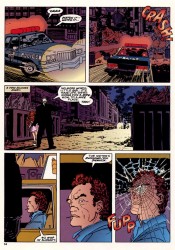
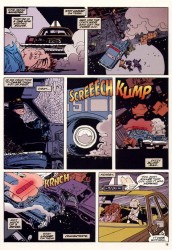
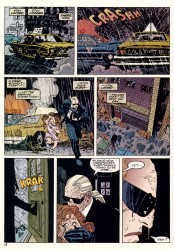
Frank Miller’s Batman doesn’t kill. He decided to, he wanted to, in Dark Knight Returns, but chose mercy for the Joker instead at the last possible moment. In Dark Knight Strikes Again, Batman condones killing, and is happy when Lex Luthor gets maced by Hawkboy, but the only life he actually takes is Dick Grayson, and he regrets that choice. The heroes of Sin City are something else entirely. Marv, Dwight, Gail, the girls of Old Town, Miho, and almost every character has a body count by the end of their run. Life is cheap, and their bullets are nameless. Miho is especially brutal, not being averse to toying with a man before he dies. Miller’s got no problem writing people who think that killing is as easy as breathing.
Daredevil, though, is something different. In the classic final issue of his run on Daredevil, “Roulette,” Miller has Daredevil place a gun to a helpless Bullseye’s head. He thinks over their past, and eventually proclaims that, when it comes to killing Bullseye, his “gun has no bullets.” He can’t murder him in his bed, no matter how much he wants to deep down inside.
Frank Miller’s Daredevil has two aspects that make him so entertaining. One is his intense sense of morality. He believes in the law and the rules, and works in his day job to prove the supremacy of those rules. The other is his flawed nature. His nighttime gig allows him to make shortcuts to, or circumvent, the law as he likes, dispensing justice at the end of a baton or his fist. This causes him no end of internal strife, and the crux of “Roulette” is that his morality is greater than his weakness.
Man Without Fear, Miller’s 1993 retelling of Daredevil’s origin with John Romita Jr, shows the kinds of situation where Daredevil will kill. The last action scene in the book is a chase, with a pre-Daredevil Matt Murdock fighting to rescue a young girl who has been kidnapped by a goon. One man dies by accident at the beginning of the fight, and Matt’s forced to stab another with his own knife while fighting underwater. What’s key is what he thinks as he’s killing the man: “A knife– no choice– give it back to him.”
Murdock is practical. When there’s no other choice to be found, you’ve got to do what you’ve got to do. He leaves the rest of the men unconscious or broken. There is a very controlled application of force to be found in Murdock’s style of crime fighting. While he occasionally loses it, or gets wrapped up in his own arrogance and goes too far, Daredevil generally knows exactly how to walk the thin line of being a vigilante.
Later in the book, Murdock intentionally kills a man. He’s put in a situation where he dies, the girl dies, or the villain dies. He begs the villain to stand down, saying, “I don’t want to kill you. Let her go.” The villain pops a shot off, winging Murdock’s arm. Murdock repeats his plea. The man fires again, and again, and Murdock swats the last bullet back at him, hitting him square between the eyes.
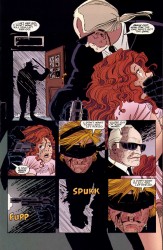
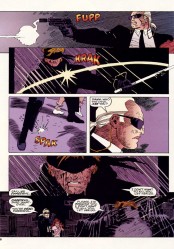
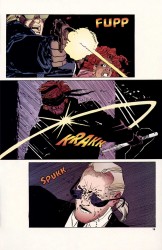
Mere moments before their encounter, the man kills a cabbie. He tells the horrified little girl he’s kidnapped that “It was nothing.” Four pages later, he’s dead and the contrast couldn’t be clearer. He killed because it was convenient. He took the path of least resistance. Murdock, on the other hand, only did it when there was no other option. It isn’t a habit, it isn’t something he’s proud of, it’s simply something that has to be done.
Miller’s Murdock is the hero who will make the hard choice, who will weigh his options, who knows his limits, and will not hesitate when it comes to doing a bad thing in order to do the right thing. It’s a refreshing change from most of the hardline “heroes don’t kill!” interpretations you see in comics. When given a choice between a child and a murderer, he chose the child. He didn’t waffle when faced with the choice. He told the man what would happen, he gave the man a choice, and the man chose poorly.

he could’ve rpoe a doped him – swat all the bullets till there weren’t any in the mag.
rope a doped
You say Batman doesn’t kill in DKR, so can you explain the bit on page 64 (of my TPB)? In it, he takes the machine gun from one of the mutant gang members, and the other holds a kid hostage, saying “Believe me, I will” and then he drops as Batman responds, “I believe you.”
I always got the impression that he just shot the gang member, which has made his attitude towards the Joker at the end rather confusing
@CasinoGrande: It’s ambiguous enough that I don’t think he killed him. There are plenty of ways to shoot without killing, ways Batman would know, and if Batman had killed a guy, it wouldn’t have just never been mentioned again.
@edc: With the rapidly disintegrating baton? C’mon.
[…] 4thletter! Booze, Broads, & Bullets: Ronin Booze, Broads, & Bullets: Elektra Lives Again Booze, Broads, & Bullets: Man Without Fear […]